- In Japan’s small-theater scene, it is often the case that the same artist writes and directs the plays, and in some also acts in their plays, but as a director in your Gekidan Chiten company, you have pursued a unique style of theater. You write in detail about that methodology and approach in your recently published book Omoshirokereba OK? (Is just being interesting OK?) (Goryu Shoin publishing). What I found especially interesting was, for example, when you directed an adaptation of Chekhov’s Uncle Vanya, you dissected the line that says, “kusakari ha sukkari sunda to iu no ni mainichi ame bakari” (Our hay is all cut and rotting in these daily rains), into “kusakari (hay cutting) …sukkari (all, completely) …sunda (finished) …mainichi (daily) …ame (rain). Then you added your own critical measure and USED DEVICES SUCH AS having the actor deliver the line as, “KUSAKARI ha SUKKARI SUNDA to iu no ni MAINICHI AME BAKKARISEKKAKU…” to very unique experimental effect. You were born in 1973 and you attended Toho Gakuen School of Music for college ad studied in the Drama Department. From that time did you already intend to become a theater director?
- I went to Toho Gakuen with the intention of becoming an actor. Toho is a two-year Jr. College and in those first two years I trained as an actor. After that I did another two years in the Drama Major Course, so I studied a total of four years there. In the Drama Major Course there were independent stage productions and that is where I did my first directing. At that time, I got the vague feeling that I was better suited to directing than acting. I was still just a student, though, so there wasn’t much faith behind that feeling (laughs).
- Who were the professors in the Drama Major Course?
- The director Mitsumasa Shinozaki was there. What I learned most from at that time was Shinozaki-san’s approach to theater and his methodology. Also I participated as an actor in plays directed by Yukio Ninagawa and Koichi Kimura.
- Shinozaki-san is known for his “Shinozaki System” of actor training method. Were you influenced by that?
- I was. The Stanislavsky system is very complicated when you read it, but Shinozaki-san presents a very easy-to-understand resume of actor training that was quite informative for me at the time. Particularly what he says about “ma” (dramatic pause, interval, timing), which he breaks down into three types of pause in drama, the mental/philosophical pause, biological/natural pause and physical-cause pause. That analysis was extremely fresh and thought provoking for me. When the “….” Indicating a pause appears in a play script, most actors tend to interpret it a mental/philosophical pause, which tends to lead to over-dramatization. He says not to get caught in that trap. Turning a page in a book is a biological/natural pause and there is nothing inherently dramatic about it, but avant-garde types may modify the action as a certain type of deliberate action (style of movement). The biological/natural pause is one that is caused by a happening, such as the silence after a cup is dropped. That is the way the system is used. It really opened my eyes.
- What plays did you do in college?
- In the first year of our major course we did Kunio Kishida’s Dialog Printanier, which is a short dialog piece, and Oriza Hirata’s short work Omoidasenai Yume no Ikutsuka (Some dreams I can’t remember) and Aho Ressha (Travel on Train) as an omnibus production. The plays were staged in a train set. I didn’t know Hirata-san at the time, but one of the actors from the Seinendan company happened to have come as an instructor and we were using those plays as study material. When I said that I wanted to direct the works, Hirata-san came to see our production and said encouragingly that it was interesting (laughs), so I decided going into directing wouldn’t be bad.
- That is when your acquaintance with Hirata-san began?
- Yes. That experience made me want to go and see actual productions of his plays, and the first one I saw was Tokyo Notes. I saw it from a second balcony seat of the Agora Theater and I remember what a strong tension there was to the atmosphere it created. I love his play S Kogen Kara (From S Plateau) and since there happened to be a performance in Akita Pref. where my hometown is, I volunteered to help out as a stagehand because I wanted to watch the rehearsals. I found those rehearsals fascinating. One of the notation you often see in the scripts of Hirata plays is “Three seconds later,” and I was surprised to see that they actually timed those pauses quite seriously. From up in the stage exit Hirata-san would say, “How many seconds was that?” and then say, “OK, add another two seconds.” (Laughs) I thought, “These people are too much!” but as I watched I began to understand the meaning of that directing method. I found it to be very much connected to the analysis of “dramatic pause” that Shinozaki-san speaks of. I then began to identify with it strongly.
- After graduation did you immediately enter the directing department of the theater company Seinendan?
- In fact, it was SCOT’s Tadashi Suzuki who influenced me most. You could even say that it was seeing his King Lear as a student that made me want to do theater. It got me going to the summer Toga Festival every year. So, when I graduated I was having difficulty choosing between going to the Mito Arts Center ACM Theater where Suzuki-san was artistic director at the time or going to audition for the Seinendan company. But, since Suzuki-san is as old as my father, I eventually decided to go to Seinendan where people were closer to my age.
In Seinendan you have a young member’s performance in your first year with the company and your performance there is judged to decide if you will be allowed to stay with the company. I was told after that performance that I couldn’t stay as an actor. But I got a letter from Hirata-san after that saying clearly that if I wanted to join the directing department I should contact him. So I started my activities as a first-year member of the directing department. That involved doing a lot of things, from working in the theater’s business department as an Agora Theater employee to cleaning the toilets, and in my free time I did rehearsals for the independent performances. - As a director, did you never think of writing your own plays?
- Since I had studied at Toho Gakuen, I had the idea that doing both writing and directing was a phenomenon unique to Japan’s small-theater world and that in the orthodox approach to theater the director, playwright and actor are separate disciplines. There were some people there who had come from high school drama clubs and liked to write their own scripts, but I found them incredibly boring and wondered why anyone would want to make a play out of such dairy-like material, and believed firmly that it could never become theater. So, I never thought of writing my own plays.
- In the Seinendan company’s directing department did you serve as a director’s assistant for Hirata-san?
- I was not a director’s assistant in the usual sense. Hirata-san is the kind of person who says, “I don’t need a director’s assistant. My computer is my director’s assistant.” (Laughs) He does everything by himself, and he doesn’t need anyone to make tea for him. What Hirata-san wants of you is that you work to become independent and self-sufficient. He says if you want to be the director, go out and convince the actors yourself. He tells you to write a proposal and then make presentations and do workshops to convince people how interesting it is. So, within that type of environment, I was just quietly watching him direct rehearsals. And watching him direct, I came to realize what his next instructions would be and how he would direct the actors. Boken oh (King of Adventure) is another Hirata work I love, and when I was watching him in rehearsals for that play I came to understand the mechanism for putting a work together. After that, I felt confident that I was ready to direct. That is how systematic his directing method took shape in my mind, and after that it became even more fascinating to watch him direct rehearsals. Of course, Hirata-san is also human, so when there is something especially important that he wants to come out in the actor’s lines, he can be very demanding, and I learned a lot from the way he got the actors to deliver their lines at times like that.
If I were asked if Hirata-san has influenced my directing style, I would say that I don’t think he has not influenced me in specific ways. I still think often about Shinozaki-san’s talk about dramatic pause, but I believe that what I really learned from Hirata-san is how to become independent and how to put together a working group. - From 1999 you spent two years on an Agency for Cultural Affairs research grant working with directors in France at places like the Théâtre Gérard Philipe Centre Dramatique National in Paris. What led to your going to France?
- In my first year of the major course at Toho Gakuen, I went along on a study trip to Russia and visited places like the Moscow Arts Theatre student training center and Chekov’s home. The next year I went to the RADA in London and the West End and got some exposure to film acting. I also went to see the Julliard School in New York. We also stopped in Paris, but for just three days. At that time I didn’t speak much English and I couldn’t get much out of that time. But I got the sense that there were a great variety of theatre arts to be found in Paris. So, I decided that if I could get a government grant to study abroad it would be in Paris.
I was lucky that when I entered Seinendan there was a Seinendan International Exchange Program recently begun and one of the projects was producing a French translation of Tokyo Notes. In connection with that project the French director Frederic Fisbach came to Japan and did a small play at Seinendan, for which I was able to take part as director’s assistant. That play was Nous, les héros by Jean-Luc Lagarce. Those kinds of specific connections led me to feel that I had to go to Paris. - What about your French?
- I took an intensive course in French at the Athenee Francais school in Tokyo.
- What were your two years in France like?
- First, I went to work in the theater as director’s assistant to Frederic on the French-language production of Tokyo Notes. After that I went to the theater of a progressive director Stanislas Nordey that Frederic introduced me to. It was highly experimental, cutting-edge theater they were doing, but due to financial difficulties it had to shut down. So, unfortunately, I was only able to experience one production there with Stanislas. Also, I was able to be involved in almost all of the new works done at the Brest (Le Quartz) in Brittany where Frederic was the senior director. In addition to working in the rehearsal studio, I was able to study theater management there as well.
After coming back from Paris, I did the production Chiten 2 – Dansho, Suzue Toshiro. I have often been told that my directing style changed drastically with that play. I tried a style where you walk slowly and deliver your lines slowly and generally do as you please, but it didn’t turn out to be very interesting (laughs). Looking back, I realize it turned out that way because of the strong influence of Claude Regy. Regy is a director who places great importance on the French language in the way he has his actors deliver their lines, and although his works are contemporary theater, the movement of the actors is slow like Japanese Noh theater.
At the time, Regy was already in his late 70s but still active, and his production of Jon Fosse’s Someone Is Going To Come was truly wonderful. His stages simply involve delivering the lines slowly and there is no cutting of the text, so a performance of a play like Someone Is Going To Come takes about three hours altogether. It is a type of directing that succeeds sometimes and clearly doesn’t succeed other times, but I liked it.
I also watched Peter Brook’s production of Hamlet. I didn’t think I would like it much, but when you actually watch it and see how the so-called “empty space” works and how it is enough to just lay out a carpet and have the actors standing there. They stand there and recite Shakespeare. I realized, “So, this is it. This is how the lines can be set down. Set down and delivered as narrative.” In Japan, people are always striving for realism in acting, but that experience made me realize that theater is in fact a form of speech-giving.
I also found Comedy Francaise interesting. The French today look down on it and no one goes to see it but Molière theater is actually quite impressive. The actors are highly skilled and deliver their stories with great expertise. Of course it is old in style and orthodox but it erased my aversion to classical theater in one fell swoop and got me reading the drama classics once again. - Could you tell us in some more detail what it was that interested you about Regy?
- Just by having the actors deliver their lines slowly, makes the listener hear the words in their pure and inherent form. For example, Someone Is Going To Come in French is Quelqu’un va venir, but under Regy’s direction it is stretched out at a very slow tempo to become Quelqu—’un va venir—. You might think that would just make it long and heavy and sleep-inducing, but when it works, you hear the words in all their fullness and the expressive meaning they hold. It creates a presence where the actors almost sound as if they are praying.
I have only seen it in video but in Shogo Ohta’s “silent theater” work Mizu no Eki (Water Station) the slow pace of motion creates the impression that each and every bit of motion represents a precious and irreplaceable moment in time. There is a feeling of fertile richness that makes you forget the passage of time. Watching Regy’s Someone Is Going To Come made me feel like I was watching a verbalized version of Mizu no Eki. There tends to be a sharp division between those who like it and those who don’t like Regy’s directing. I thought that that kind of work should not be disregarded. - Is the importance you place on verbal delivery in your directing an influence from Regy?
- I think that influence is considerable, but that is not the entirety. In fact, the learning method employed in the intensive French course I took at the Athenee Francais school was extremely new and interesting to me. You use a hand mirror [to watch your own mouth] as you practice “a” “b” “c” “d” … to correct your pronunciation thoroughly, to the point that you are actually drooling and need a handkerchief in the other hand. You begin with the pronunciation of the alphabet to learn the sounds that French is constructed from and also all the other aspects, using both linguistic and scientific analysis. That corrective approach language instruction was very interesting to me. The concept of diction proved to me to be a theatrical experience.
- When I saw the production of Chekov’s Three Sisters it thoroughly surprised me. You boldly restructured the original Chekov text but that did not result in a dissection of Chekov. On the contrary the result produced very faithful images of the original play. What’s more, your staging was completely different from the “realism theater” we have known up until now and so was the acting method. The way the lines were pronounced and the delivery were also different. How much of this unique style was formulated in your mind while you were in France?
- I like television a lot, and while I was in France I often watched TV. But, on the news programs they speak so fast that I couldn’t understand much of what was being said. So, I would often find myself thinking completely different things as I watched. Every night I would come home after a day at the theater and I would turn on the TV and leave it on as I thought about the plays I watched. So, the effect was that every day I was experiencing a state where the things I was looking at and the things I was hearing were different and I was not understanding the meaning of much of the French I was hearing and things were constantly out of harmony with what I was thinking about at the time. If I was going to see a classical play, I knew I wouldn’t understand the language being used, so I would read a translation before I went, but even then I couldn’t understand the meaning. The daily repetition of those types of experiences was a form of training for me. It was from that time that I began to think that language used on stage should be even more different than what you could call “discrepancy between word and action” or naturalism in movement.
- Adding new critical interpretation and changing the structure of classical play texts is something that Tadashi Suzuki has also done, isn’t it?
- As I said earlier, there is naturally an influence of Suzuki-san’s work in mine. Actually, there was a period in my second and third years of college when I was thinking that I had had enough of doing theater. At that time, I would go to Shimokitazawa or Shibuya after classes and watch one play after another, perhaps 200 or so in one year. I also kept a theater diary of notes about the things I had seen. I had probably begun to look at plays critically from around that time. The ones I found interesting I would watch three times or so. There were definitely some interesting works, but on the whole I was beginning to think that I had seen enough theater and it wasn’t for me.
- You were born in 1973, so that period in your life must have been in the early 1990s, wasn’t it?
- Yes. And it was just when I had begun to feel that way that I had an experience I will never forget. There happened to be a flyer for SCOT’s Toga Festival in the folder for a play I went to see in Shimokitazawa. I had read Suzuki-san’s book What is Theater? (Engeki to ha Nanika) but since his plays were not performed in Tokyo, I had never actually been to see one. I thought it was something I shouldn’t miss, so I went to the festival. What I saw was a finished production what could be called Suzuki-version King Lear, and it was truly a shocking experience for me. I had seen many plays up until that point in time but I got the feeling that with this play I was seeing true “theater” for the first time. It was a great surprise for me and it left me veritably stunned and motionless for some time.
I felt that the approach to theater was completely different from anything I had seen until then. I don’t especially like Shakespeare, and I had normally felt that it was strange when Japanese actors tried to do Shakespeare. But when I saw Suzuki’s King Lear I realized that I had been missing the point of what theater really is. I realized that theater was an act of presenting something critical, and it was platform for showing the “distance” to what you have been thinking. It made me feel that I was seeing true contemporary theater for the first time.
After that I went to the Toga Festival every year and studied Suzuki-san’s approach to theater. What influenced me most from all of this was his use of the wheelchair as a stage device. I think it is amazing that he came up with that idea. Suzuki-san’s wheelchair might be considered an equivalent to the faucet that Shogo Ohta used in his Water Station plays. When an actor is sitting in the wheelchair, an automatic division between the upper body and the lower body is created. With that wheelchair he was able to give visual expression to the “story-telling body” and the “moving body.”
I realized that true directing was coming up with devices like this wheelchair. It has been more than just a case of me being influenced by Suzuki-san, I have even done a good bit of outright stealing from him (laughs). It is not an exaggeration to say that is how I staged Three Sisters. And it is the same with the human-sized baskets used in [Suzuki’s] Ivanov (Chekov). When the actors are wearing those baskets, they can hide inside and then poke their head out of the basket suddenly and then pull it back in. The audience laughs, but it is in fact no laughing matter. Because using those baskets provides you with the means for instantaneous stage entrances and exits. I thought that inventing devices like this is something that a director can and should do.
When the Three Sisters production was ready I wrote a letter to Suzuki-san and told him that a young director he has never met has finally created a stage that I could show him with pride. And he actually came to the performance and praised me for it. That made me feel—perhaps prematurely—that I could finally leave my mentors behind and strike out on my own. It also got me thinking about what I could do that even Suzuki-san hasn’t done yet. - What made you decide to move your base of operations to Kyoto?
- The fact that I had gone independent from Seinendan and the fact that Kyoto is something like Paris. And I also thought that the size of the city is just right and it is an easy place to put works together. My father was a company man who was constantly being shifted to offices around the country, so I was used to moving here and there since childhood, and personally I am not one who feels rooted to any particular place. Like a pro baseball player who is willing to move to any city that has a good franchise.
- I would like to ask you about the stage art and sets that your company Chiten creates. To me the sets appear simple, symbolic and beautiful. I hear that you place importance of staff-work, but can you tell us how the set planning is done?
- We hold repeated staff meetings. I don’t go into the meetings with some specific plan for the stage art that I try to communicate through drawings or the like. When I have something I want to communicate to the staff I do it only through words. And it is usually single words. For example, a word like kehai (a “sense” of something present). In my director’s notes as well, it is just individual words that I write. They are long lists of words that have come to mind or words in the original script that have caught my imagination or troubled me.
From those notes I bring out words in our meetings, like, “Three Sisters is actually a play about the fact that they can’t go to Moscow,” or, “Is it really a drama about the fact they can’t go to Moscow?” Or, in meetings we may have exchanges like, “The prop is going to be pajamas,” then, “Maybe it should be a negligee,” then, “No, make it a bed sheet.” Then when we actually try it, I may say, “I guess this won’t work.” Then the stage artist takes that home and thinks about it until the next meeting to make a new proposal that we will then work on again in the rehearsals. In that process of trial and error we will try things and drop them, try something else and drop it, until we gradually find the things we want.
So, what I have in my own head is not images but only words. It is the feelings = connections that are born from words. For example, “ennui.” What I want to do appears from out of words like that. Taking those words as hints, the actors think about their lines, the stage artist thinks about the set, the lighting artist thinks about the light design. That is how it works. We all explore the feelings = connections that are born from words like that as we create a work. Then we talk and come to conclusions like, “This may be good.” However, in the end I am the one who makes the final decisions about what the audience will see. Which often involves shifting things to the right or left in increments down to one centimeter. - You mean with the final parts of the set?
- Yes. I think there is something inside that even I am not aware of. I am not a writer. I don’t even have the desire to write. I have never thought that I wanted to become a painter. I have never thought of giving expression to something I created all by myself. I like to “watch” things. I like to watch something in a particular environment and then try moving it around. That is why I always say to the staff, “There is nothing that I want to be done.” (Laughs)
- You did a production Atashi-chan, Ikusaki Itte (Little Me, Say Where You’re Going) in which you used not only a play by Shogo Ohta but also all the texts of critiques and the like. It seems to me that your work is fundamentally similar to the way Ohta-san directed plays.
- In the case of Suzuki-san, I was able to see his productions live, but in the case of Ohta-san, his Tenkei Gekijo company was already dissolved when I came along, so I never saw one of the stages he directed. The first work by Ohta that I saw was Sarachi (Vacant Lot) and I didn’t understand it at all. I wouldn’t say that it was boring, but I didn’t find it was interesting. Then, when I saw Mizu no Eki (Water Station) in video, I couldn’t keep from watching it over and over. I thought it was truly amazing. In the sense of time it created, the way the plot was developed …. I feel that Suzuki-san is short-tempered, or has a talent for creating short but exceedingly intense moments of concentration. In contrast, I realized the Ohta-san’s work is more magnanimous, but possesses a single point of frustration that he is able to maintain at an extremely high level.
That is why Ohta-san is a mysterious entity for me. He has passed away now, but he was someone who was always so interesting to be with and I always felt that the things he was thinking were much more progressive than my thoughts. When he came to see the production of Jericho (by Masataka Matsuda) in Kyoto, he was all excited, saying to me, “That was fantastic!” Although I may sound presumptuous, he didn’t have the aura of a great master of playwriting but was young in spirit and we had a relationship like a pair of young theater freaks who could watch a play together and poke at each other’s weaknesses. I was never able to see one of his Tenkei Gekijo productions live, but I was able to witness first-hand his principles concerning theater, including the things he had doubts about. And, in fact, it was Ohta-san who saw my production of Three Sisters and told me that I should do all four of Chekov’s masterworks. - Could you explain to us more about why you take the texts of plays apart and restructure them?
- I don’t think I have ever read a play with the intention of restructuring or recomposing it. It is rather the case that when I read it I get the desire to do the parts that I get stuck on. That is why I have no answer when I am asked what my purpose is in restructuring plays. It is not a case of restructuring because of some particular effect I want to achieve based on some particular interpretation. In one sense it is a matter of intuition. If it were possible to do a play based on the prerequisite that it was forbidden to change the text in any way, I don’t think anything could be easier than that. But that is not the case. The problem is that it is just too much of a struggle for me to do the play as it exists.
When I think about why that is true for me, I believe it is because the most important thing for me is the essence behind the words. I believe it is because of my nature that makes me like Chuya Nakahara or that made me want to become a poet when I was an adolescent. To me literature is poetry. That is why I can’t keep from taking apart a play and restructuring it. It is because I believe that in some sense the script is like a poem. - So it is intuition and not a case of having a particular theme for the recomposing.
- That’s right. I am picking out the words that I get stuck on. But, of course, there is some tendency toward the types of words that catch my attention and hold my interest. Because one of my hidden themes is Beckett and there is an underflow of Beckett in my philosophy of theater, I unconsciously get caught on Beckett-like things. That is connected to the question of what contemporary theater is or should be. It has to do with “the absence of story” and with existentialism and with a questioning of independence as expressed in such words as, “That is not me.”
- So, there are things that you get stuck on, and that is then put into something of a collection of words through a process involving interaction within a certain group of people [staff]. What then is the final process involved in putting that result before an audience [as a play]?
- That is the gray zone, and the aspect that involves the greatest struggle and questioning. The set and words go through a process of “assimilation” that I call affordance. What is necessary is a process in which the words and the [stage] space come to accommodate each other, or come into “affordance” with each other. I just said earlier that for me the script is a poem, it is a song, and if that is true it would mean that it would be enough just to recite it or tell it as a story, wouldn’t it? But it isn’t that way, because there are live human beings acting it out there [on the stage]. Because it also involves the physical presence of the actors, there needs to be a formula of accommodation, like a “multiplication involving the set.” And when that process [of staging] reaches a certain level of completion, most of the problem words that I was stuck on at the initial stage have now been resolved. And in the most fortunate of cases, by the time they are forgotten, in some sort of absurd resurrection the words will pop up again with a comment like, “That was interesting after all.” And when that happens those words will stand out with a shining resonance. They stand out again in some completely different flow of context. That was the case with Chekov.
- Although you use the word hatsugo (delivery, pronunciation), you don’t use the word katari (speaking, recitation, story-telling), do you?
- Since katari becomes a matter of reciting a story, I deliberately use the word hatsugo (delivery) in order to make a distinction from recitation. In my book Omoshirokereba OK ka? (Is just being interesting OK?) I use the word katari when I write about “speaking to the audience.” But that is because the word “audience” is the object of the word “speaking” (kataru). However, it is not story-telling. What the actor is actually saying is “aa…” or “uu…;” that is how far I believe we have dissected the text. So there is no “story” being told. And so, when I say “speak to the audience” I mean, “Get deliberately involved with the audience. I mean, use “aa…” and “uu…” to force involvement with the audience.
- Does that mean that various feelings or meanings can be expressed with “aa…” or “uu…”?
- Going to extremes, it means that you can do Chekov using just the word “is.” You can’t do it with just “aa…”, but I believe that in the case of Japanese you can do Chekov with just the word desu (is) or the particles “wo” or the “ha” of “watashi ha” (I am). In that sense, the theater I do may be like the extreme of trying to talk to a foreigner whose language you don’t know (laughs). Perhaps I want to believe that even if you don’t know the meaning of the words, you can still show something just through the involvement of the actors.
Motoi Miura
Giving expression to dissected texts
The new possibilities of compositional theater pioneered by Motoi Miura

Motoi Miura
Born 1973. Graduated Toho Gakuen Jr. College, department of theater, Toho Gakuen Major Course. Joined Seinendan theater company in 1996, became member of the directing department. Studied and worked in theater in Paris for two years on an Agency for Cultural Affairs research grant from 1999. Returned to Japan in 2001 and acted as representative of the Seinendan Link company Chiten from 2003 to 2005. Became independent of Seinendan in April of 2005 and moved Chiten’s base of operations to Kyoto. That year he won the Outstanding Performance Award of the Toga Director Contest for his production of The Seagull (by A. Chekov). From 2007 he began a project to mount productions of the four great masterpieces of Chekov and won the Agency for Cultural Affairs New Director Award for the third production of this series, The Cherry Orchard. In 2010 he published his first book Omoshirokereba OK ka? (Is just being interesting OK?) (Goryu Shoin publishing). Named for Special Accomplishment in Culture for the City of Kyoto, 2008.
(Interviewer: Akihiko Senda)
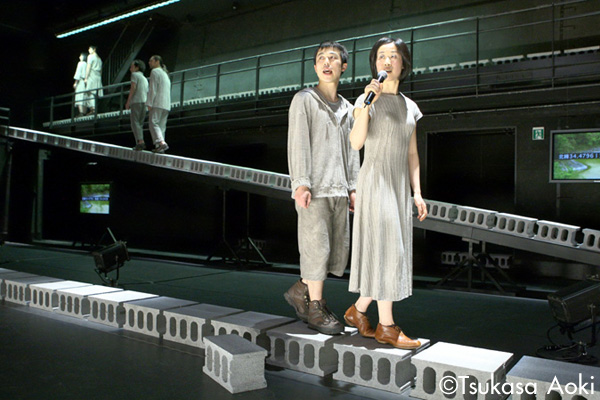
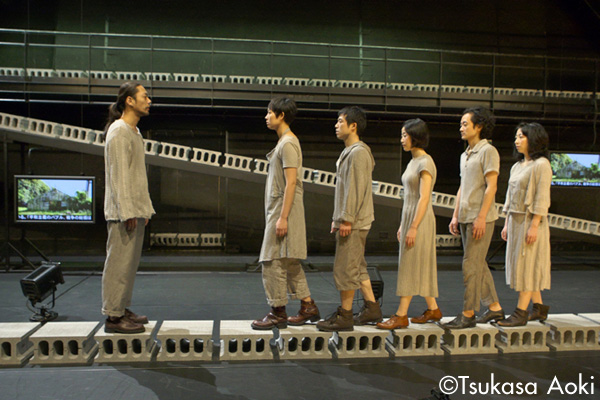
Chiten
Atashi-chan, Ikusaki Itte (Little Me, Say Where You’re Going) – from the full text of Shogo Ohta
(Jan. 2010 at Kichijoji Theatre)
Photo: Tsukasa Aoki
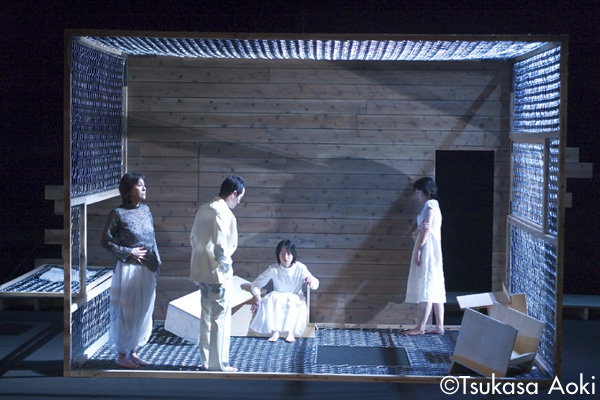
Chiten
A Summer’s Day
(Written by Jon Fosse)
(2004 at Fujimi Culture Hall “Kirari Fujimi”)
Photo: Tsukasa Aoki

Chiten
The Name
(Written by Jon Fosse)
(2004 at Fujimi Culture Hall “Kirari Fujimi”)
Photo: Tsukasa Aoki
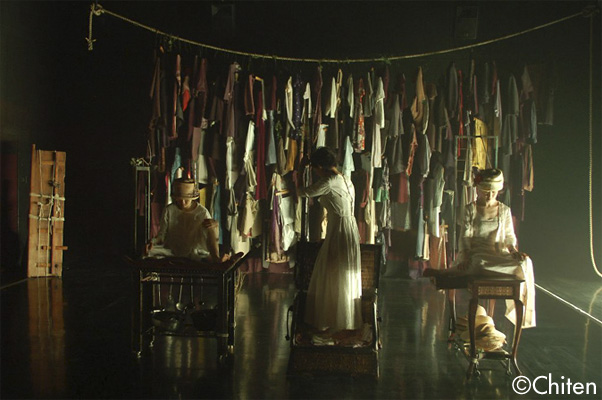
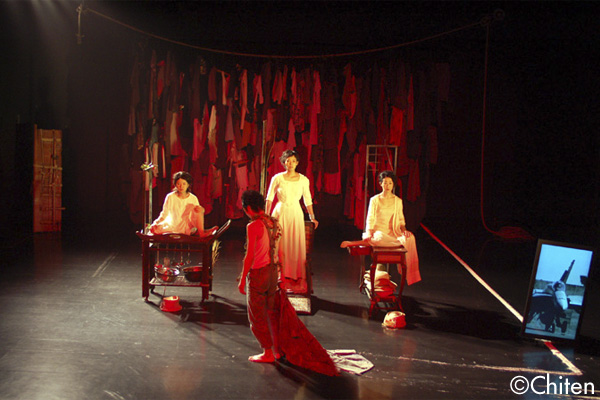
Chiten
Three Sisters
(Jul. 2008 at Osaka Geijutsu Sozokan)
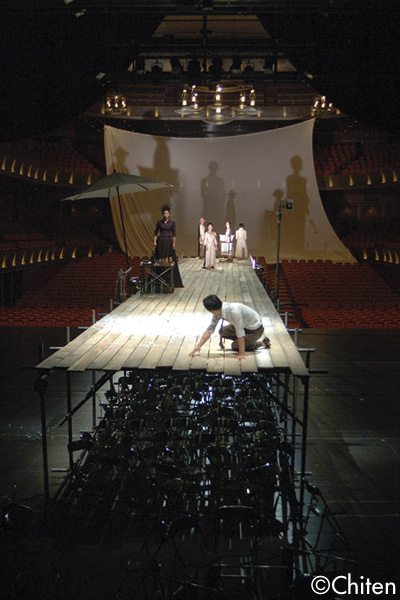
Chiten
The Seagull
(Aug. 2007 at Biwako Hall Center for the Performing Arts, Shiga)
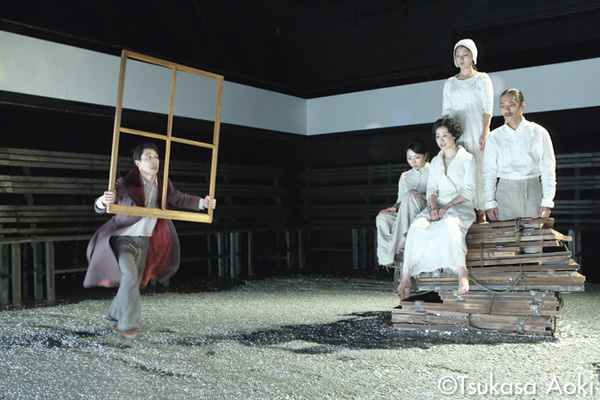
Chiten
The Cherry Orchard
(Oct. 2008 at Kichijoji Theatre)
Photo: Tsukasa Aoki
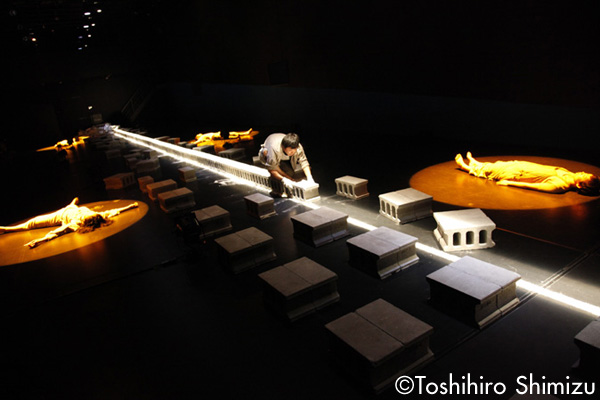
Chiten
Atashi-chan, Ikusaki Itte (Little Me, Say Where You’re Going) – from the full text of Shogo Ohta
(Sep. 2009 at Kyoto Performing Arts Center-studio21)
Photo: Toshihiro Shimizu

